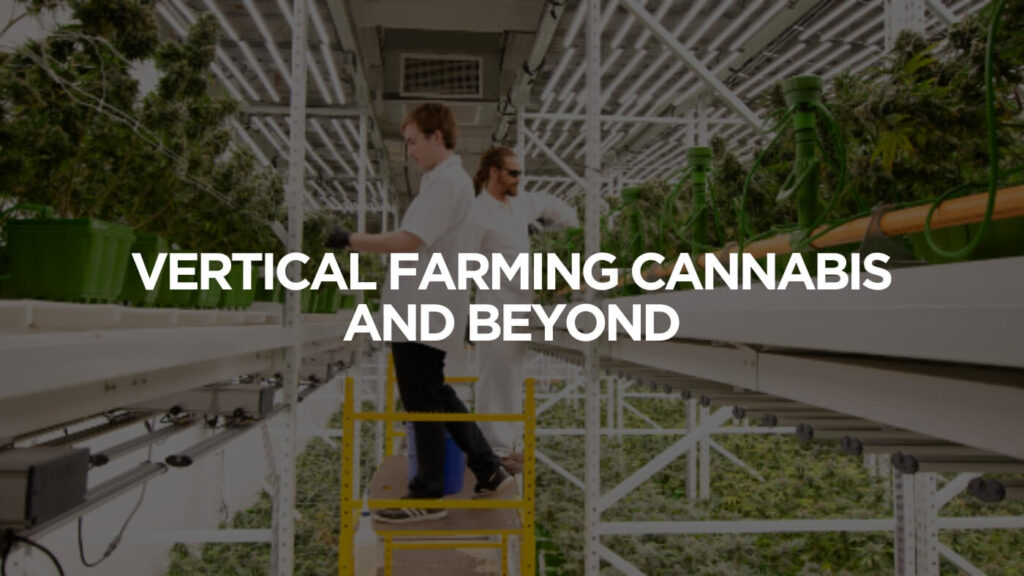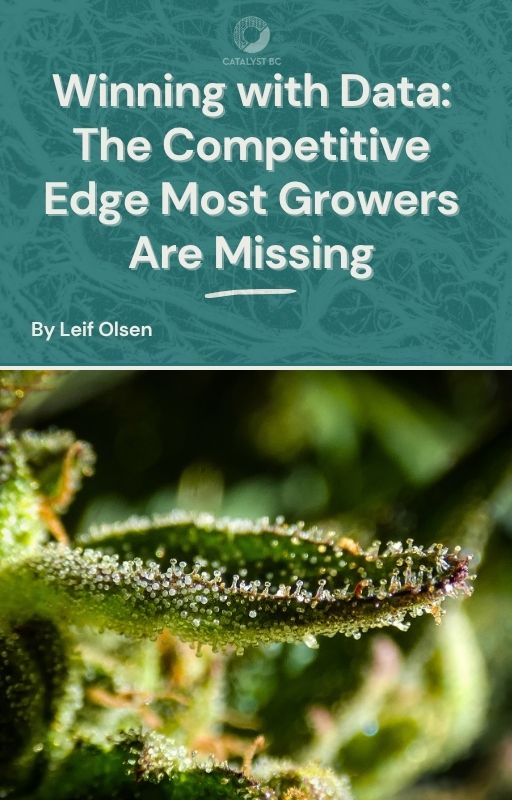Estimated reading time: 13 minutes
Table of contents
- Introduction
- Cannabis Industry: Presenting A Budding Potential
- Benefits Of Vertical Growing Systems For Cannabis Cultivation
- Technologies Driving Vertical Farming Success
- Vertical Farming Challenges
- Beyond Cannabis: Vertical Farming For Other Crops
- Cannabis Consultants: Empowering Growth And Success In The Industry
- A Few Last Words
- Vertical Farming For Cannabis And Beyond FAQ
- Additional Resources
- Free eBooks For Cannabis Business Success
- Latest Articles
Introduction
As the demand for cannabis continues to rise worldwide, the cultivation industry is constantly evolving to meet the needs of both consumers and producers. One technique that has gained significant attention in recent years is vertical farming cannabis.
This innovative method represents a paradigm shift in the way we approach agriculture. Gone are the days of sprawling farmland, as vertical farming harnesses innovative techniques to cultivate crops in vertically stacked layers or structures.
In this blog, we will explore the intricacies of vertical farming for cannabis and its endless possibilities for agriculture as a whole. We’ll delve into different cultivation techniques, and shed light on cutting-edge technologies.
So find a seat, get comfortable, and join us on this adventure to the exciting world of vertical cannabis grow systems and beyond.
Cannabis Industry: Presenting A Budding Potential
The cannabis industry has experienced remarkable transformations in recent years and shifting public attitudes has further highlighted its immense potential.
This once-stigmatized plant is now being viewed through a different lens as governments and societies recognize its medicinal applications, economic opportunities, and potential for social change.
The Medicinal Revolution
Cannabis plants have a rich history of medicinal use dating back thousands of years. Today, modern science and research are uncovering the plant’s potential with groundbreaking discoveries.
This has led to the establishment of various medical cannabis programs in many countries, offering users a natural alternative to traditional pharmaceutical treatments.
Economic Growth And Job Creation
The cannabis industry has emerged as a significant driver of economic growth and job creation in many countries, especially the U.S.
Cannabis sales have skyrocketed, generating billions of dollars in revenue. This economic surge translates into job opportunities in agriculture, research and development, marketing, compliance, and many other sectors.
Innovations And Research
The cannabis industry is driving innovation and breakthroughs across numerous fields. Researchers are exploring new cultivation techniques, perfecting extraction methods for cannabinoids and terpenes, and developing novel delivery systems.
This research is unlocking the full potential of the cannabis industry, enhancing user experience, and expanding product offerings. Additionally, advancements in genetic research are leading to the development of new strains with specific properties and profiles tailored to various needs.
Understanding Cannabis Vertical Farming
Vertical farming cannabis and beyond involves the cultivation of crops in vertically stacked layers or racks. In this method, cultivators use artificial lighting, hydroponic or aeroponic systems, and advanced environmental controls to ensure optimal results.
Unlike traditional farming methods which rely on vast stretches of land, vertical farming allows growers to take advantage of limited space effectively. This makes it an attractive option for urban areas with limited acreage.
Here, we take a look at different systems of vertical farming in cannabis cultivation:
Vertical Racking Systems
Vertical racking systems are the backbone of vertical farm cannabis and beyond. These systems typically consist of stacked trays or shelves, providing multiple layers for plant cultivation.
The design facilitates easy access, efficient irrigation, and customizable lighting setups. Moreover, with the help of automation and robotics, plants can be moved, rotated, and monitored effortlessly, ensuring their well-being and maximizing productivity.
Hydroponics
Hydroponics is a widely used technique in cannabis vertical farms This method involves suspending cannabis plant roots in nutrient-rich water solutions, allowing them to directly access the necessary minerals and elements for growth.
The absence of soil eliminates the risk of soil-borne diseases, reduces water consumption, and increases the nutrient intake efficiency of the plants.
Aeroponics
Aeroponics takes vertical farming a step further by misting the dangling cannabis roots with a nutrient solution. This way, suspended roots receive a fine misting of nutrient-rich water, oxygen, and other essential elements.
This method promotes rapid growth, minimizes the risk of pathogens, and allows for better absorption of nutrients, resulting in healthier final products.
LED Lighting Systems
Vertical growing systems rely heavily on artificial lighting and LED (Light Emitting Diode) technology has emerged as the preferred choice among many master growers. LEDs are energy-efficient and produce less heat compared to traditional lighting sources such as High-Pressure Sodium (HPS) lamps.
This allows growers to optimize plant development, promote higher yields, and achieve desired cannabinoid profiles.
Do you still have questions about vertical farming? Find out When You Should Hire A Master Grower and how their knowledge can help enhance your cultivation system in our blog.
Environmental Control Systems
Vertical farming requires precise control over environmental factors like temperature, humidity, CO2 levels, and air circulation. High-tech environmental control systems continuously collect data, enabling growers to make real-time adjustments.
In addition, automated systems regulate these factors, creating a stable environment that enhances plant health and growth.
Benefits Of Vertical Growing Systems For Cannabis Cultivation
Now that we have covered the basics of vertical farming and beyond, it’s time to explore its numerous benefits and uncover how it can enhance efficiency, sustainability, and yields.
Maximizing Space Utilization
Vertical farming allows cannabis enterprises to overcome the problems associated with limited land availability. By stacking and tiering growing platforms, growers can multiply their cultivation area without expanding horizontally.
Precise Environmental Control
One of the key advantages of vertical growing systems is the ability to create an ideal climate for cannabis growth. Control over airflow, humidity, light, and CO2 levels enables growers to optimize plant health and accelerate growth cycles.
Year-Round Cultivation
Traditional outdoor cultivation is often limited to specific seasons due to climate restrictions. Vertical farming eliminates this barrier by enabling year-round cultivation, independent of external weather conditions.
By providing a controlled indoor environment, growers can harvest multiple crops throughout the year, enhancing productivity and delivering a consistent supply to meet market demands.
Increased Crop Quality and Yield
Cannabis grown in vertical farms consistently exhibits higher cannabinoid profiles, terpene content, and overall potency. This optimized cultivation environment also contributes to higher yields, ensuring a more sustainable and profitable operation.
You can read more on optimizing the cultivation process in our post, 10 Recommendations To Increase Output.
Sustainability and Resource Efficiency
Vertical farming embraces sustainable practices by minimizing water consumption, reducing pesticide usage, and lowering carbon footprint. By utilizing hydroponic or aeroponic systems, growers can reduce water usage significantly compared to traditional soil-based cultivation.
Moreover, the controlled environment minimizes the need for chemical pesticides, promoting natural pest control methods. Vertical farming also reduces transportation distances, making it a more eco-friendly option for cannabis production.
Technologies Driving Vertical Farming Success
Technologies in vertical farming have opened up new and exciting possibilities for the future. As we move towards a world with limited arable land and a growing demand for cannabis products, these advancements will pave the way for a more sustainable and efficient industry.
IoT (Internet of Things) Sensors
IoT sensors play a vital role in vertical farming by monitoring essential parameters such as temperature, humidity, pH levels, nutrient concentrations, and lighting. This data helps growers make informed decisions, detect abnormalities, and automate adjustments to create optimal growing conditions.
Vertical Cannabis Farming Software
Advanced software platforms enable growers to streamline operations, manage data analytics, and remotely control various aspects of their vertical farms. These data help track crop performance and set personalized cultivation parameters for different strains.
Vertical Farming Challenges
Like any agricultural technique, vertical farming presents its own set of unique challenges. Here, we take a look at some of the key challenges faced by growers in this field and discuss possible solutions to overcome them.
Space Limitations
While vertical farming maximizes space utilization compared to traditional farming methods, there are still inherent limitations. The vertical stacking of plants requires careful planning and optimization of available space.
Inadequate spacing between plants can lead to reduced light penetration, restricted airflow, and increased risks of disease and pests. To overcome this challenge, growers need to design efficient layouts by taking advantage of adjustable shelving systems and considering plant size and growth characteristics.
Adequate Lighting
Providing adequate and appropriate light intensity and spectrum is essential for cannabis vertical farming. Growers need to select and position lighting fixtures carefully, taking into account light intensity, coverage, and spectrum.
Additionally, it`s crucial to manage heat dissipation from light fixtures to prevent overheating in enclosed vertical environments.
Nutrient Delivery And Management
Achieving and maintaining proper nutrient concentrations, pH levels, and water quality is pivotal for plant health and productivity. Nutrient imbalances or fluctuations in the solutions can negatively impact plant growth and compromise crop quality.
Constant monitoring, robust water management protocols, and periodic nutrient solution analysis are crucial for maintaining optimal nutrient delivery.
Cost Considerations
Implementing and operating a cannabis vertical farming system can involve significant upfront costs, especially considering factors such as lighting, HVAC systems, automation, and facility construction. Energy costs associated with lighting and climate control can also be substantial.
Businesses must carefully evaluate the return on investment (ROI) potential and manage operating expenses to ensure long-term viability and success in the market. Advancements in technology and supportive regulations can help address cost challenges over time.
Beyond Cannabis: Vertical Farming For Other Crops
The potential of vertical farming techniques extends far beyond the realm of cannabis. Vertical farming has proven to be a game-changer in the agriculture industry, offering a sustainable solution for cultivating various crops, from leafy greens and vegetables to herbs, spices, fruits, and even exotic flowers.
Leafy Greens And Vegetables
One of the main applications of vertical farming is in the production of leafy greens and vegetables. The controlled environment in this method is especially suitable for delicate crops.
Leafy greens like lettuce, spinach, and kale thrive in these environments, ensuring a consistent and abundant supply of fresh, nutrient-rich produce.
Herbs, Spices, And Medicinal Plants
Vertical farming is the perfect way to cultivate herbs, spices, and medicinal plants. These crops often require specific environmental conditions, which can be challenging to maintain outdoors.
Herbs like basil, mint, and cilantro flourish in vertical farm settings, where factors like light intensity, nutrient delivery, and air circulation are precisely controlled. This allows the plants to reach optimal growth, offering enhanced flavors and extended shelf life.
Fruits And Exotic Flowers
Vertical farming is suitable for growing a range of fruits and exotic flowers in urban environments. Traditionally, these crops require vast stretches of farmland, specific climate conditions, and long transportation distances to reach consumers.
However, vertical farms can bring fruit cultivation closer to urban centers, reducing carbon footprint.
Local Food Production And Urban Agriculture
One of the most significant advantages of vertical farming lies in its potential for local food production and urban agriculture. As the global population continues to grow and urban areas expand, the need for locally sourced products becomes more obvious.
Vertical farms located inside or near urban centers can supply locally-grown food throughout the year. By reducing long-distance transportation, these farms contribute to a more sustainable food system.
Cannabis Consultants: Empowering Growth And Success In The Industry
In the rapidly evolving cannabis industry, navigating the complex landscape can be a daunting task for businesses. Cannabis consultants provide invaluable expertise, guidance, and strategic insights to help individuals and organizations thrive in this competitive market.
The Role Of Cannabis Consultants
Cannabis consultants are industry professionals with specialized knowledge and experience across various sectors of the cannabis market. They offer strategic and practical support to businesses at every stage, from startup ventures to established enterprises.
Cannabis consultants bring expertise in areas such as Cannabis Cultivation Facility Design, operations management, cultivation techniques, product development, branding and marketing, distribution, and more.
By leveraging their deep understanding of the industry, consultants help clients navigate challenges, identify opportunities, and optimize their business operations. Find out 10 Areas A Cannabis Consultant May Offer Value.
Catalyst BC: Your Trusted Partner In Cannabis Consulting
When it comes to cannabis consulting, Catalyst BC stands out as a trailblazer in the industry. With an exceptional team of consultants, we offer comprehensive services that cover the full spectrum of the industry.
At Catalyst BC, we understand the intricacies of the cannabis market, and we are committed to helping our clients succeed in this burgeoning industry. Our team of experienced consultants offers a wide range of services tailored to meet the specific needs of cannabis entrepreneurs, businesses, and investors.
Whether you’re looking to enter the market, expand your operations, or ensure compliance with regulations, we’ve got you covered!
Catalyst BC consultants stay updated on the latest industry trends and market dynamics to provide efficient and customized insights. We help our clients make informed decisions by offering comprehensive market research, competitive analysis, and strategic planning.
From cultivation and production to retail and distribution, we assist businesses in optimizing their operations for efficiency, quality, and scalability.
A Few Last Words
Vertical farming for cannabis and beyond offers innovative and sustainable solutions. Its efficient use of space, reduced water consumption, and controlled environment make it an appealing choice for the future of agriculture.
By employing cutting-edge technologies, vertical farms can optimize plant growth, maximize yields, and overcome the limitations of traditional farming methods. This not only benefits the cannabis industry but also extends to the cultivation of other crops such as leafy greens, herbs, strawberries, and tomatoes.
Embracing vertical farming for a diverse range of crops can help address global food security challenges, reduce reliance on long-distance transportation, and create a more sustainable future.
Catalyst BC stands ready to help businesses seize the opportunities of vertical farming. So, if you’re ready to take your cannabis business to new heights, seize this opportunity, and partner with Catalyst BC.
Don’t let industry challenges hold you back. Contact the Catalyst BC team today and start your journey toward unparalleled success.
Vertical Farming For Cannabis And Beyond FAQ
What is vertical farming, and why is it suitable for cannabis cultivation?
Vertical farming is a modern agriculture method in which crops are grown vertically in stacked layers. In this method, cultivators use indoor systems to optimize space and control environmental conditions. Vertical farming can benefit cannabis cultivation as it offers higher yields and maximizes land use.
How does vertical farming address the issue of limited space for cannabis cultivation?
Vertical farming utilizes available space efficiently by stacking plants in vertical layers. This stacking creates multiple layers, enabling growers to maximize their cultivation area and achieve higher crop densities while still maintaining optimal growing conditions.
What lighting considerations are important for vertical farming of cannabis?
Lighting plays a crucial role in vertical farming methods. Growers need to carefully select lighting fixtures that provide adequate intensity and spectrum to support various growth stages. Additionally, it`s essential to position lighting sources properly to ensure uniform light penetration across all layers.
How do growers maintain optimal environmental conditions in vertical farming systems?
Maintaining optimal environmental conditions requires effective heating, ventilation, and air conditioning (HVAC) systems. These systems regulate temperature, humidity, airflow, and carbon dioxide levels. Moreover, sensor technology and automated controls enable cultivators to monitor and adjust climatic conditions to ensure consistent and ideal growing environments.
Additional Resources
Free eBooks For Cannabis Business Success
Latest Articles
- Cannabis 280E Compliance and COGS Optimization Expert StrategiesThe cannabis industry operates under a unique federal tax burden imposed by Internal Revenue Code (IRC) §280E. While state legalization has flourished, this provision, which denies deductions for ordinary business expenses of trades dealing in controlled substances, remains the single greatest threat to cannabis profitability.
- Owner’s Rep for Cannabis Dispensary Buildout: Expert Compliance & Project ManagementNavigating the highly-regulated world of a cannabis dispensary buildout requires specialized expertise beyond standard construction. The complexity of securing a final operating license, controlling costs, and preventing opening delays for a cannabis dispensary hinges on professional guidance. This is why securing an experienced Owner’s Rep for Cannabis Dispensary Buildout is a critical first step.
- The Indispensable Owner’s Rep for Cannabis Cultivation Facility Buildout: Expert Project Management to Prevent Cost OverrunsIn this high-stakes arena, the Owner’s Rep for Cannabis Cultivation Facility buildout is the crucial strategic partner. They are the expert professional who ensures the owner’s vision is translated into a successful, operational, and profitable reality.
- Cannabis Dispensary Compliance: Training, Inventory & ProfitabilityIn today’s regulated cannabis market, cannabis dispensary compliance is not optional—it is the foundation of a sustainable and profitable retail business. Every dispensary, from boutique shops to multi-state operators, must follow strict dispensary regulatory compliance standards, maintain accurate cannabis inventory management systems, and invest in ongoing cannabis dispensary training programs.
- Beyond Compliance: Implementing a Cannabis Dispensary Secret Shopper ProgramAs a cannabis retail owner, you operate in a high-stakes environment where federal prohibition meets state-regulated commerce. Your retail floor is not just a sales hub—it’s a constant target for mandatory inspection and the front line for brand differentiation. The most critical tool for navigating this complex reality is the professional, recurring Cannabis Secret Shopper program.
- Architects of the Cannabis Industry: What Defines An Expert Canna Consultant?An expert Canna Consultant is the strategic architect and operational engineer of a cannabis venture. They are specialized cannabis industry consultants who translate ambiguous legislation into profitable business processes.











